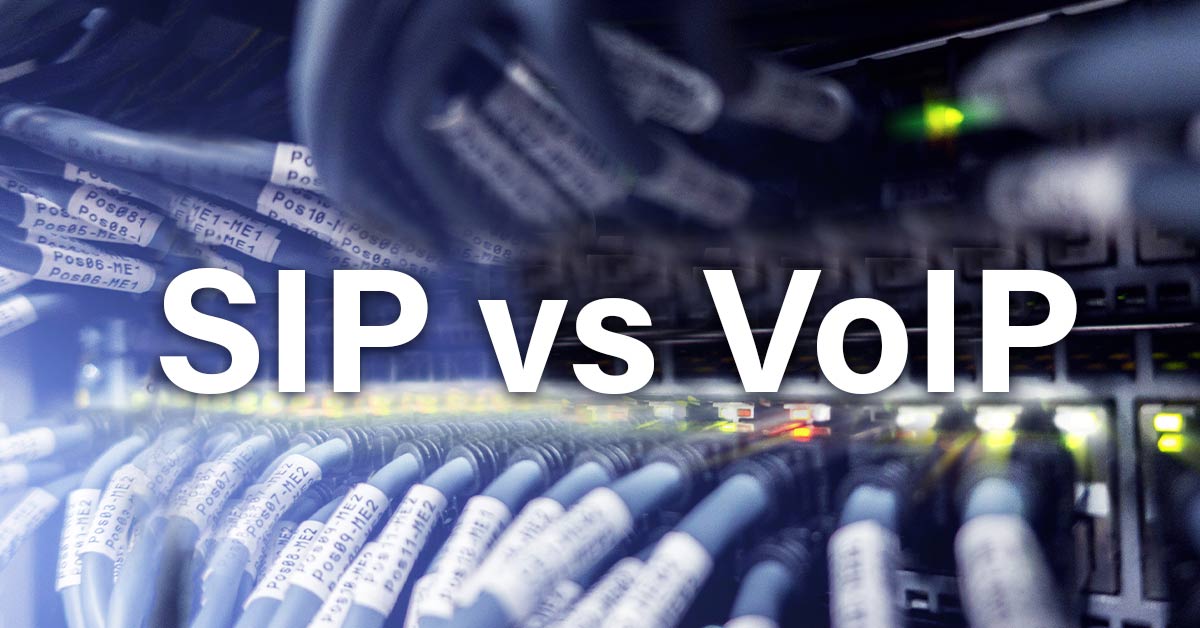
Have you ever wondered how your voice travels through the internet making conversations possible? Then you should learn about the power players of modern telephony – SIP vs VoIP. This dynamic duo has reshaped how we connect and converse over digital calls.
Did you know? By 2025, experts predict that over 3 billion users worldwide will rely on VoIP services for their daily communication needs.
But what sets SIP apart from VoIP? Join us as we explore these telecommunication titans – SIP vs VoIP differences, working, benefits, and the future they promise.
What is VoIP?
VoIP stands for Voice over Internet Protocol. It is a technology that enables voice communication over the Internet. VoIP works entirely differently from traditional telephone systems. In the traditional setup, calls are made through the wired lines using the PSTN i.e. Public Switch Telephone Network.
VoIP converts analog signals into digital data packets for wireless communication. Compared to expensive traditional phone services, VoIP is a popular cost-effective alternative that has been widely adopted around the world.
VoIP has seen significant adoption globally, with businesses and individuals leveraging its benefits such as cost savings, flexibility, and scalability. According to a report, the global VoIP market is expected to reach a value of $194.5 billion by 2024.
VoIP is extensively used in business scenarios for internal and external communication. It is also a popular choice when it comes to personal communication. Some of the most popularly used applications to use VoIP services are Skype, WhatsApp, Viber, etc.
This blog is about VoIP vs SIP, both of which are protocols. So you should know what a protocol is all about.
Here’s the simple definition:
A protocol is a set of rules that devices follow to communicate with each other efficiently and accurately. Protocols ensure that devices can understand each other and exchange information accurately and efficiently.
How does VoIP Work?
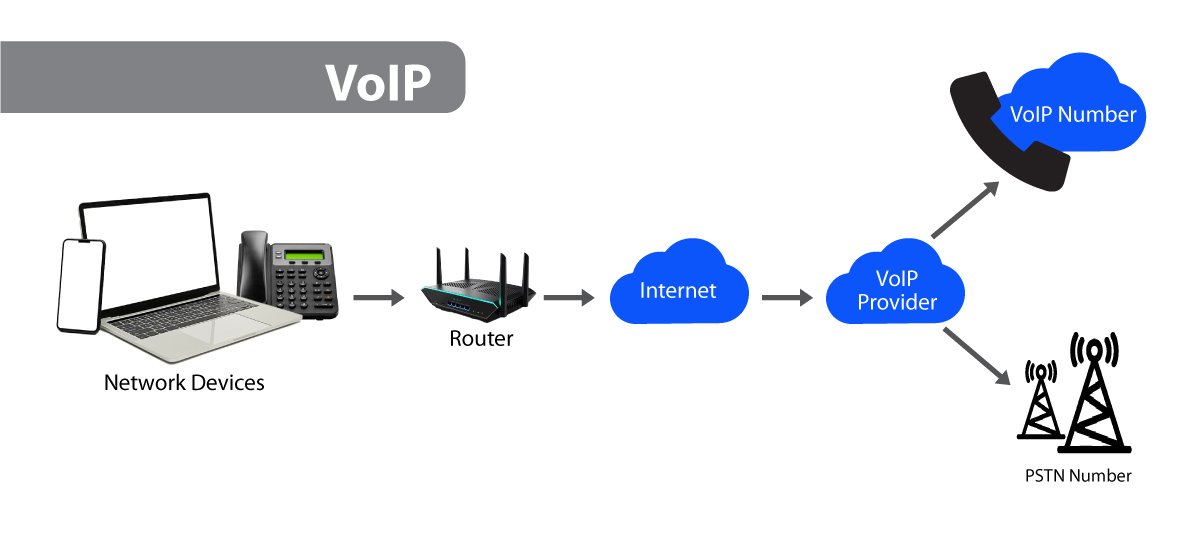 VoIP makes use of packet-switching technology for the transmission of audio signals. When you place a call using your VoIP device, the local VoIP network connects the device with a carrier network. Then the VoIP device which could be a laptop, deskphone, etc., converts your voice into packets that are transmitted over the internet. At the receiving end, these packets are reassembled and converted back into sound, heard by the recipient.
VoIP makes use of packet-switching technology for the transmission of audio signals. When you place a call using your VoIP device, the local VoIP network connects the device with a carrier network. Then the VoIP device which could be a laptop, deskphone, etc., converts your voice into packets that are transmitted over the internet. At the receiving end, these packets are reassembled and converted back into sound, heard by the recipient.
Hosted Vs Non-Hosted VoIP
VoIP infrastructure includes both hardware and software elements that work together to deliver the service. For you to avail of VoIP service, there are two options:
Hosted VoIP
In the hosted VoIP model, the business avails services from a third-party vendor. This vendor owns and maintains the infrastructure such as the server and other hardware. You as a business can avail of VoIP services from the vendor for a fee. The hosted VoIP model comes out to be quite cost-effective as you don’t need to make any huge investments.
On-Premise VoIP
Also called non-hosted VoIP, this model works on the concept of ‘self-owned infrastructure’. On-premise VoIP is a good option for large-sized organizations as businesses will be responsible for the housing and maintenance of the VoIP infrastructure.
Expert Suggestion: When choosing between hosted and non-hosted VoIP, consider the trade-offs: hosted solutions offer convenience and scalability with potentially higher long-term costs, while non-hosted solutions provide greater control and customization but require more upfront investment in infrastructure and maintenance. Select based on your priorities for control, flexibility, and budget.
VoIP Pros and Cons
Pros
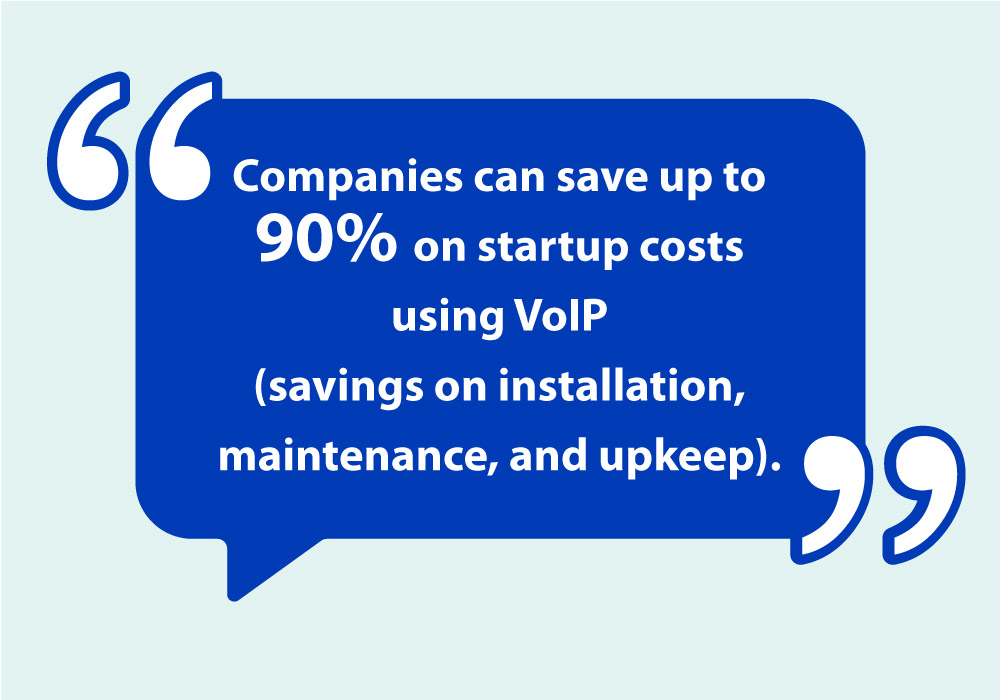
- Offers affordable setup with minimal upfront investment
- Offers consistent ongoing savings with fixed monthly billing
- Most VoIP providers offer flexible contracts
- Even basic VoIP plans often include essential features like Call waiting and forwarding.
Cons
- Relies on adequate bandwidth for service availability and optimal call quality.
- Certain basic VoIP services may lack mobile integration or dedicated mobile apps.
- Voice-centric service doesn’t support multimedia communications.
What is SIP?
SIP is a signaling protocol that is used to manage multimedia communication sessions over the Internet. These multimedia sessions may include voice, video, and other aspects of unified communications.
Session Initiation Protocol or SIP facilitates the traveling of messages between endpoints. It initiates, maintains, and terminates communication sessions between endpoints. In addition to voice, SIP is also used for video conferencing, IM i.e. Instant Messaging, media distribution, and other applications. It is therefore a much more flexible technology compared to VoIP.
SIP is predominantly used in VoIP and various unified communication solutions for seamless integration of voice, video, and messaging across multiple devices and applications.
How SIP work?
In the first step, SIP establishes the session. This is done by sending data packets that carry the message between two endpoints. When a call is initiated from one end, an invite signal is triggered. This invite traverses through proxy servers, functioning akin to automated switchboard operators. The proxy server relays the call invitation to the receiving endpoint, which responds using a SIP-enabled device to accept the call.
What is SIP Trunking?

SIP Trunking is another term that is used frequently when topics about internet calls are discussed. SIP trunking is enabled by the SIP protocol. It involves using SIP to create a virtual connection between a company’s PBX system and the PSTN over the internet. It helps businesses eliminate the need to connect with physical phone lines.
SIP Trunking allows businesses to transmit voice and multimedia sessions using their IP-based phone system. Overall, it provides a scalable, flexible, and cost-effective solution compared to traditional phone lines.
SIP trunking is a method to use VoIP (internet-based calling) with your office phones. You can set it up in two ways:
- Using SIP trunking with your own system (IP PBX) at your office.
- Or, you can choose a hosted PBX where an outside VoIP provider manages and maintains your phone system for you.
SIP trunking is like a bridge that links your office phone system to both the internet and regular phone lines (PSTN). It lets you make calls to any phone using only the Internet.
How SIP Trunking Works?
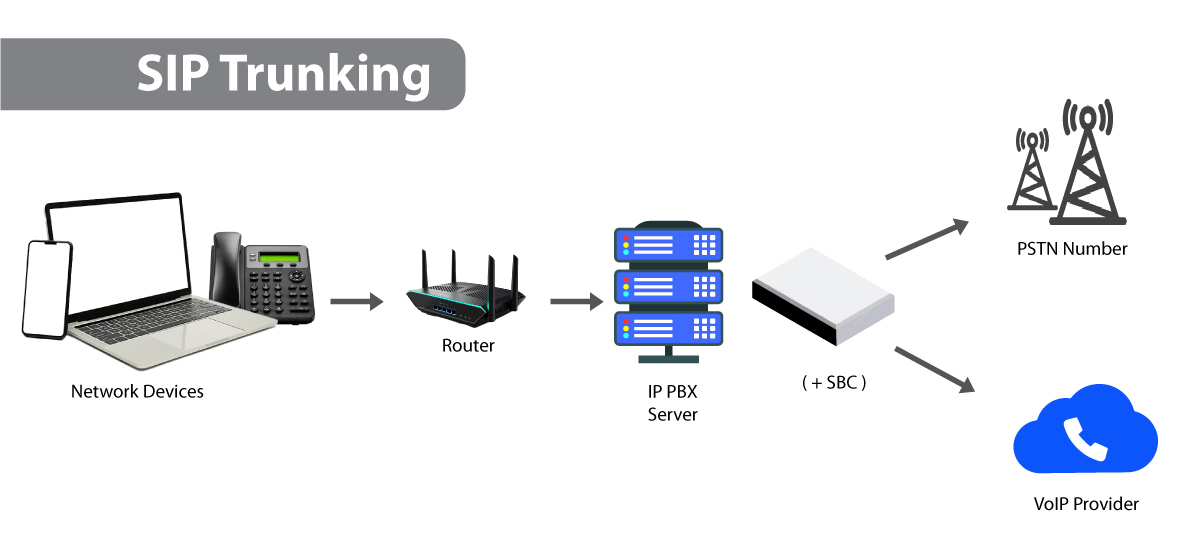
SIP trunking leverages the internet and SIP protocols to establish a virtual connection. Here’s the detailed working:
To link a business’s phone system (IP PBX) to regular phone lines (PSTN), SIP trunks use a session border controller (SBC). This SBC can be hardware connected to your router or software downloaded onto a computer, router, or your phone system itself. The SBC, placed at the edge of your office network, safely manages when internet-based calls, like VoIP, start and stop.
A regular phone system uses cables and PRI lines only for wired calls through the phone network. But an IP phone system sends calls as data over a network, like the company’s internet. SIP trunking combines both, letting people use the internet to make calls through regular phone lines or just using the internet.
A SIP trunk comprises numerous channels, with each SIP trunk channel facilitating a single phone call. When initiating an outbound call via your SIP trunk, your device triggers a session that occupies one channel. This channel links your call to the public internet or your telecom carrier’s network, signaling the completion of the call. If another individual places a call on your SIP trunk simultaneously, a different channel is utilized, yet both calls are transmitted over the same trunk.
Expert Tip: Prioritize SIP trunking providers that offer scalability and redundancy to ensure seamless call routing, clear communication, and reliable service. Additionally, consider providers with strong customer support and robust security measures to safeguard your communication infrastructure.
Difference Between VoIP and SIP Trunking
Usually, both SIP vs VoIP are used when referring to making phone calls over the internet cloud. Are SIP vs VoIP the same? If you have this question in mind, then the answer is No. Here’s an explanation of the differences between SIP Trunk vs VoIP:
SIP trunking and VoIP might seem similar, but they’re not quite the same. SIP trunking is a way to set up your office phone system (IP PBX), while VoIP is all about making calls over the internet. Think of SIP trunking as a method, and VoIP as the actual online calling. SIP trunking is one way to make VoIP happen. VoIP happens because of SIP trunking, but you can also get VoIP using different methods, not just SIP trunking.
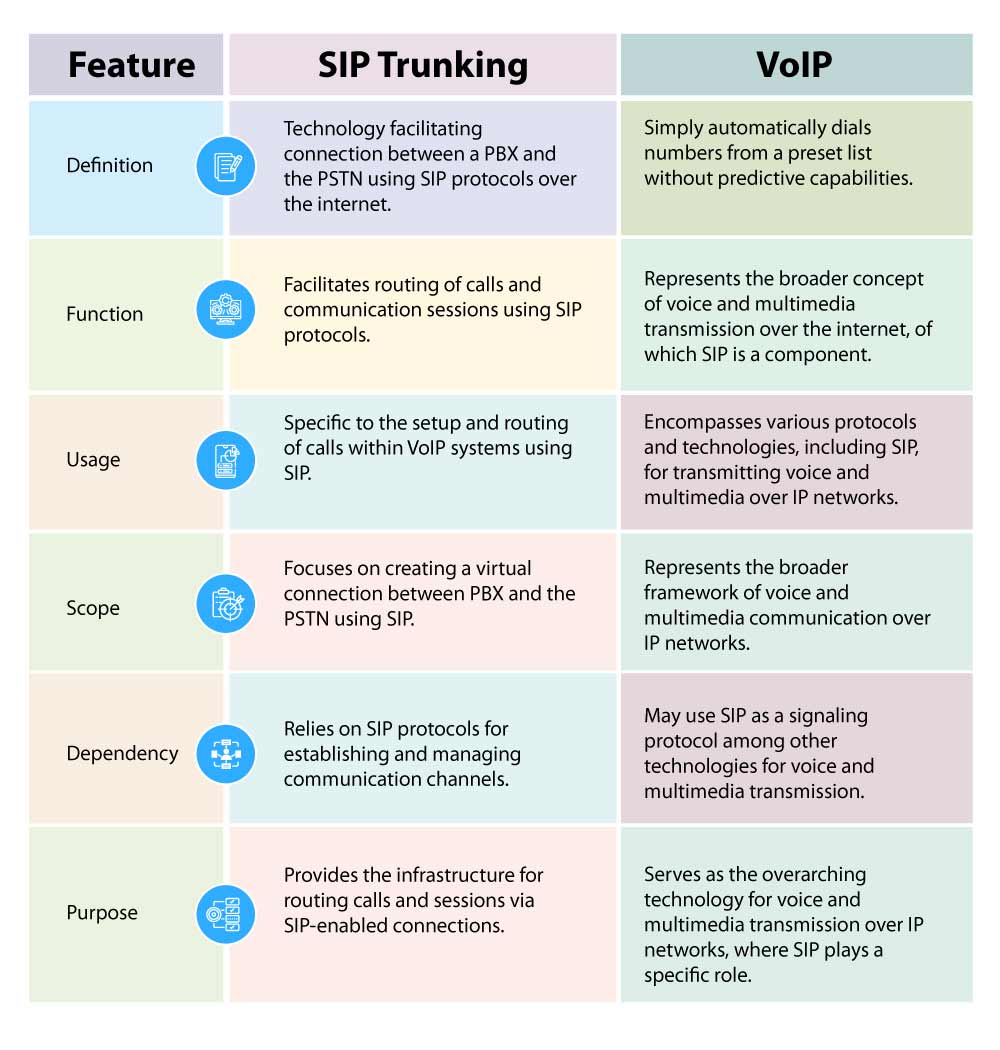
What is VoIP SIP?
It refers to the integration of VoIP vs SIP i.e. combining both technologies. Here in this context, VoIP SIP represents the usage of SIP as the signaling protocol within VoIP systems. The amalgamation of VoIP vs SIP enables voice and multimedia sessions over the Internet.
VoIP SIP Implementation: Real-life Examples
Business Communication
VoIP SIP is deployed by businesses for their internal and external communication needs. For example, a business having multiple branches or remote offices uses VoIP vs SIP. Through this, employees can make calls, do video conferencing, and exchange/share data seamlessly over the cloud.
VoIP Service Providers
A telecom service provider can use VoIP SIP as a part of its infrastructure for offering voice services to clients. SIP enables users to make calls over IP networks offering cost-effective and feature-rich calling solutions.
Mobile Apps
Popular OTT apps like Skype, and WhatsApp leverage VoIP SIP to offer voice and video calling features. These apps leverage SIP protocols to establish and manage communication sessions between users globally.
Unified Communications Platforms
Platforms like Microsoft Teams, Zoom, or Cisco Webex utilize VoIP SIP for their audio and video conferencing functionalities. These platforms leverage SIP to enable users to initiate and manage real-time communication sessions across different devices and locations.
SIP vs VoIP: Which Solution Should You Use for Business?
Certainly, you need a top-notch communication system for your business. So which is the best choice for your business – SIP or VoIP? It is understood that VoIP vs SIP are not comparable because their functionality is different. Based on the role these
technologies play, you need to decide whether VoIP alone would be suitable or you you require a more comprehensive and robust solution like VoIP powered with SIP.
By now we know that both SIP and VoIP enable Voice calls. If your business is entirely focused on voice calls, then VoIP is the ideal option for you. However, if you are a budding organization utilizing modern communication techniques such as video conferencing, file sharing, connecting via instant chat, etc., then you certainly need SIP.
Expert Tip: Both SIP and VoIP can be vulnerable to security threats. Recognizing SIP’s role in signaling and call setup can guide in implementing security measures at this level, such as encryption and authentication, to ensure secure VoIP communication.
Here are our suggestions about when your business should use VoIP vs SIP trunking:
When to Use VoIP?
- Without an IP PBX: If you don’t have an IP PBX, it’s easier to use a cloud-based VoIP service. You won’t need to buy any special hardware.
- Without Unified Communications: If you don’t have a unified communications platform (UCaaS), a cloud-based VoIP service might be a good choice. It typically includes various features like SMS and team messaging in one software.
- Complex Routing and Queueing Needs: Cloud-based VoIP plans usually have routing and queueing features. Managing complex call routing is simpler using the phone system’s app rather than having an on-site IP PBX system.
When to Use SIP Trunking?
- With an IP PBX System: If you already have an IP PBX in your office, using a SIP trunk makes it easy to add VoIP to your phone system.
- Communication Tools without Voice: If you have tools like video conferencing or team chat but no voice calling a SIP trunking provider can help add VoIP to your existing tools and multimedia communications.
SIP vs VoIP : Let’s Conclude!
Whether using SIP trunking or cloud-based VoIP, choosing the best fit depends on what’s needed for better, cheaper, and easier communication. Finding the right mix of SIP vs VoIP paves the way for enhanced connectivity. We are telecom industry experts whom you can trust for the right assistance. Get in touch with us to learn more about SIP vs VoIP and which solution would be ideal for your business.




























